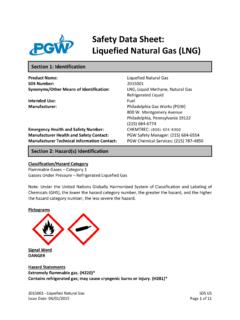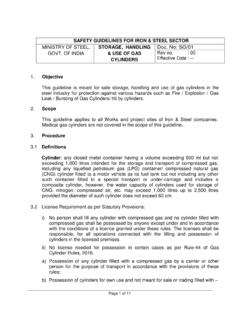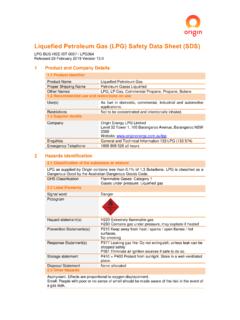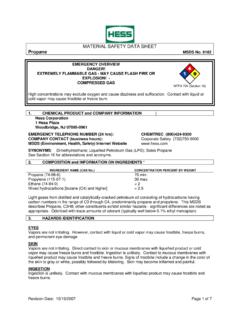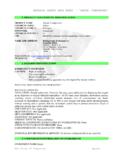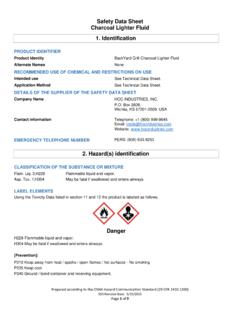Transcription of SAFETY DATA SHEET - NATURAL GAS - ATCO
1 1 of 9| Page ATCO SDS (revised April 2, 2019) NATURAL Gas Revision Date: April 02, 2019 Supersedes Date: January 31, 2019 SAFETY data SHEET - NATURAL GAS SECTION 1. PRODUCT AND COMPANY IDENTIFICATION ATCO Gas 10035 105 Street Edmonton, Alberta T5J 2V6 1-800-511-3447 (toll-free) for information Emergency Telephone : (24 hr) CANUTEC: 1-613-996-6666 (Call Collect) or (*666 on a cellular phone) PRODUCT IDENTIFICATION Manufacturer Various Suppliers, Pipeline/Distribution quality Trade Name NATURAL Gas Chemical Name Methane Synonyms NATURAL Gas/high Methane content Chemical Family Alkanes Molecular Formula CH4 (Methane) Product Use NATURAL Gas is used primarily for space and water heating and for industrial processing applications Method of Transport Pipeline (under pressure) or high pressure cylinders attached to mobile vehicles Transportation of Dangerous Goods Regulations UN 1971.
2 Class Shipping Name and Description: METHANE, COMPRESSED WHMIS Classification Compressed Gas (Class A) Flammable Gas (Class B1) SECTION 2. HAZARDOUS IDENTIFICATION Classification of the Substance or Mixture Label Elements Hazard Pictograms : Simple Asphyxiant Simple Asphyxiants Category 1; A gas that is a simple asphyxiant Gases Under Pressure Gases under pressure / Compressed gas Flam Gas 1 Flammable gases - Category 1 H220 Extremely flammable gas H280 Contains gas under pressure; may explode if heated 2 of 9| Page ATCO SDS (revised April 2, 2019) NATURAL Gas Signal Word : Danger Hazard Statements : H220 - Extremely flammable gas.
3 H280 - Contains gas under pressure; may explode if heated. H380 - May displace oxygen and cause rapid suffocation. Precautionary Statements : P210 - Keep away from heat, sparks, open flames, hot surfaces. No smoking. P377 - Leaking gas fire: Do not extinguish unless leak can be stopped safely. P381 - Eliminate all ignition sources if safe to do so. P403 - Store in a well-ventilated place. P410+P403 - Protect from sunlight. Store in a well-ventilated place. Other Hazards Exposure may aggravate those with pre-existing eye, skin, or respiratory conditions. Asphyxiant gas, can be fatal. May cause damage to the blood, central nervous system, and cardiovascular system.
4 High concentrations of gas can cause unconsciousness and death. Mercaptan is added (rotten egg odour) to the gas, however this smell should not be relied on as a good indicator of the presence of gas as olfactory fatigue (loss of smell) occurs rapidly. Being under the influence of alcohol may enhance the effects of this product. SECTION 3. COMPOSITION/INFORMATION ON INGREDIENTS Composition Hazardous Ingredients Common Name/Synonyms CAS No. % NATURAL Gas N/A 8006-14-2 100 Methane N/A 74-82-8 90-99 Ethane N/A 74-84-0 0-6 Propane N/A 74-98-6 0-3 Butane N/A 106-97-8 0-3 Propane, 2-methyl- Isobutane 75-28-5 0-3 Pentane N/A 109-66-0 0-3 Butane, 2-methyl- Isopentane 78-78-4 0-3 Nitrogen N/A 7727-37-9 0-3 Carbon dioxide N/A 124-38-9 0-3 Helium N/A 744-59-7 0-3 *typically contains <5 ppm mercaptans SECTION 4.
5 FIRST AID Skin Contact: First aid is not normally required Eye Contact: If irritation/redness develops, move victim away from exposure into fresh air And flush eyes with clean water. Inhalation: Do not enter a contaminated area unless properly protected (refer to Section 8) Move victim to uncontaminated area to fresh air Perform artificial respiration if necessary 3 of 9| Page ATCO SDS (revised April 2, 2019) NATURAL Gas Seek medical assistance Note to Physicians: Symptoms may not appear immediately 5. FIRE AND EXPLOSION HAZARD data (See Note, Section 11) Flammability In the presence of oxygen and in the presence of an ignition source Flammability Limits (percent in air) 4% - 15% Fire Extinguishing Media Dry Chemical (most effective) or carbon dioxide (CO2) or Halon Special Procedures: Shut off flow of gas from a safe location.
6 (if properly trained). Use full protective equipment and Self -contained breathing apparatus (SCBA). Do not extinguise flame until gas flow is shut off. Use gas detectors in confined spaces. Ignition Temperature Approximately 630 C (varies with temperature pressure and oxygen concentration) Auto Ignition Temperature in Air Range 482 C - 649 C Upper Explosive Limit 15% gas in air (approximately) Product of Combustion: Carbon dioxide and carbon Monoxide Protection of Firefighters: Firefighters should wear SCBA in case of oxygen deficient atmostphere. Do not extinguish unless leak can be stopped SAFETY . In case of leakage, eliminate all ignition sources.
7 Sensitivity to Static Discharge: Flammable Section 6. ACCIDENTAL RELEASE MEASURES Personal Precations: Use personal protection recommended in Section 8 Enviromental Precautions: None Leak and Spill Procedures: Evacuate area Leak/Line Break Occurs Contact emergency number (refer to Section 1) Attempt to keep area clear Do not activate any sorce of ignition such as electrical switches, vehicles, telephones, cellular phone, two way radios or door bells. Eliminate ignition sources such as open flame or sparks. Methods for Containment Stay away and upwind of spill/release Waste Disposal Vent to outside atmosphere Other information Allow to vapourize and dispense to atmosphere Section 7.
8 HANDLING AND STORAGE Handling Observe handling regulations for compressed gases and flammable materials. To be handled by trained personnel only and followed with approved operating procedures. Storage: Comply with storage regulations for compressed gases and flammable materials. No smoking or open flames in storage area. Precautions to be Taken Avoid personal body contact (skin/eye contact, etc.) with high pressure gas stream Other Precautions Avoid all possible sources of accidental ignition ( , static electricity or any other explosive source) Test for hazardous concentrations prior to entering meter stations 4 of 9| Page ATCO SDS (revised April 2, 2019) NATURAL Gas Section 8.
9 EXPOSURE CONTROLS/PERSONAL PROTECTION Exposure Guidelines Component NATURAL gas [CAS No. 8006-14-2] ACGIH: Simple asphyxiant; Explosion hazard OSHA: No PEL established. Methane [CAS No. 74-82-8] ACGIH: Simple asphyxiant; Explosion hazard OSHA: No PEL established. Ethane [CAS No. 74-84-0] ACGIH: Simple asphyxiant; Explosion hazard OSHA: No PEL established. Propane [CAS No. 74-98-6] ACGIH: Simple asphyxiant; Explosion hazard OSHA: 1000 ppm (TWA), 1800 mg/m (TWA); Butane [CAS No. 106-97-8] ACGIH: 1000 ppm (STEL); Explosion hazard (2012) OSHA: 800 ppm (TWA) [Vacated]; Isobutane [CAS No. 75-28-5] ACGIH: 1000 ppm (STEL); Explosion hazard (2012) OSHA: No PEL established.
10 Pentane [CAS No. 109-66-0] ACGIH: 1000 ppm (TWA); (2013) OSHA: 1000 ppm (TWA), 2950 mg/m (TWA); 600 ppm (TWA); 750 ppm (STEL) [Vacated]; Isopentane [CAS No. 78-78-4] ACGIH: 1000 ppm (TWA); (2013) OSHA: No PEL established. Nitrogen [CAS No. 7727-37-9] ACGIH: Simple asphyxiant OSHA: No PEL established. Carbon dioxide [CAS No. 124-38-9] ACGIH: 5000 ppm (TWA); 30000 ppm (STEL); (1983) OSHA: 5000 ppm (TWA), 9000 mg/m (TWA); Helium [CAS No. 7440-59-7] ACGIH: Simple asphyxiant OSHA: No PEL established. PEL: Permissible Exposure Limit TLV: Threshold Limit Value TWA: Time-Weighted Average STEL: Short-Term Exposure Limit 5 of 9| Page ATCO SDS (revised April 2, 2019) NATURAL Gas Engineering Controls: Use ventilation adequate to keep exposures (airborne levels of dust, fume, vapour, gas, etc.)


